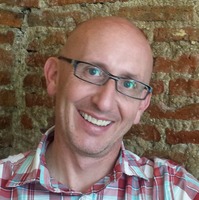Summer Program in Japan Gets Future Entrepreneurs to a ‘Better Starting Line’
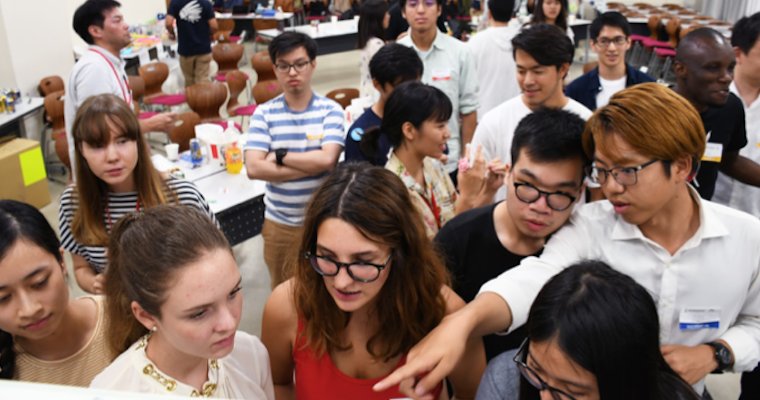
Every summer in the sweltering heat of Japanese summer, dozens of aspiring entrepreneurs, mostly students, arrive in Kyoto to participate in Japan's most intense and international summer entrepreneurship program. Through the next two weeks, they will participate in hands-on workshops, learn from more than a dozen experienced entrepreneurs and academics, and join various social activities to introduce them to the Kyoto startup scene. Throughout the program, the participants will make new connections, some of which may last a lifetime. Welcome to Kyoto Startup Summer School.
Kyoto Startup Summer School (KS³) is a two-week entrepreneurship program conducted in English, hosted by the KYOTO Design Lab (D-lab) at the Kyoto Institute of Technology (KIT). It was founded in 2016 and ran every year until Covid-19 cancelled the 2020 program. In the four years from 2016-2019, more than 120 participants from more than 40 countries joined the program, making it one of the most international entrepreneurship programs in Japan. The program is unique in both the diversity of the participants and what it teaches. Condensed in two weeks are many workshops and more than 10 lectures covering a wide range of startup topics. While the short time span is not enough to make one a seasoned entrepreneur or an expert in one field, the goal of KS³ is to introduce aspiring entrepreneurs to a variety of content so that when they do start companies, they know the relevant topics they need to master.
The goal of this article is to share the details of the program and its underlying rationale for those interested in creating similar programs at universities or other entrepreneurship centers. Also included are the profiles of the participants and the workshop facilitators and lectures. The second half shows the impact that the program has had on participants, as well as the key takeaways from running the program for four years.
Learning from Experience
The inspiration of KS³ came from my experience at an early-stage startup that failed. Before coming to the Kyoto Institute of Technology, I was part of a startup developing a semantic search engine for online shopping. The team was full of capable engineers, but no one had the entrepreneurial experience needed to succeed. As many startups do, the company focused too much on developing the product without understanding what else was necessary -- networking, pitching, marketing, growth hacking, etc. By the time the team realized this, it was too late.
Developing a successful company often requires the founders to perform a variety of tasks even if they have no background in that field. While an established company may have people and departments dedicated to operating a business, startups don't have that luxury. As a result, founders must learn how to do everything that an early-stage company requires. We designed KS³ in a modular format to cover a wide range of those topics.
KS³ began in 2016 as a two-day program, put together in a month. This was very much a "beta-test" version of the program, and about a dozen participants joined, with five different lectures teaching different modules. In 2017, we expanded the program to two weeks. With more time to prepare and promote, 16 workshop facilitators and lecturers taught 28 participants from 15 countries (out of 199 applicants). The general format of the program was established in 2017, and incremental changes were made in 2018 and 2019, such as changing the workshops and lectures or adding different kinds of modules such as startup visits. Over the years, KS³’s mission statement solidified as "getting aspiring entrepreneurs to a better starting line," and the program design reflected this.
KS³ format and modules
Early research into academic entrepreneurship programs showed that similar programs around the world often adopted Steve Blank's Lean Launchpad model. Student teams would start with a startup idea and refine it through customer interviews and expert mentorship, often culminating with a pitch at the end (Blank & Mullaney). This model can lead to student teams having startup ideas at the end of the program, but for KS³, continuing beyond the program is tremendously difficult as most participants come from different countries. Furthermore, the Lean Launchpad model focuses on customer discovery and product/market fit, but other elements of entrepreneurship are missing, such as fundraising or networking. This is not to say experiential learning is not important, but KS³ is designed in such a way that hands-on workshops are combined with lectures to cover a wider variety of topics. Compared to the Lean Launchpad model, KS³ is more content-oriented.
Week One
The first week of KS³ includes a three-day Design Thinking workshop followed by a two-day Lean Startup workshop. Through the Design Thinking workshop, the students experience the process of developing an idea from scratch through user interviews and rapid prototyping. While originally developed as a methodology for new product innovation in existing organizations, much of the mindset and approach can also be applied to early-stage startups. One of the challenges of conducting a Design Thinking workshop in Japan with English-speaking participants is that during the fieldwork, where participants go outside to interview users, most locals are not proficient with English. As such, every year the topic is related to tourism so that the participants can interview foreign tourists, who are abundant in Kyoto.
Through the Lean Startup workshop, the students learn the framework around taking an idea and creating a successful business, utilizing the business model canvas and running small experiments to test assumptions. While the methodologies and tools differ, there are similarities in the underlying philosophy between Design Thinking and Lean Startup such as "fail fast and fail cheaply."
The first week is designed to deliver not only the methodologies but also the underlying mindset for agile innovative work. In some years, the two workshops, despite being taught by different people, have been coordinated so that students take the ideas created in the Design Thinking workshop to develop further in the Lean Startup workshop. This has been an issue as some of the ideas from the first workshop couldn’t be used to create a company. Other ideas were a better fit as features of existing products/services or better operated as non-profit activities. Some participants have also commented that they didn't want to spend the entire first week working with the same people.
Week Two
The format of the second week changes over to shorter workshops and lectures. In 2019 we had five mini-workshops and 11 lectures over five days, although four of the mini-workshops were concurrent, two at a time, so participants chose to attend one or the other. The mini-workshops span four hours (one afternoon) and the following topics were covered between 2016-2019:
· How to create and share your startup story Introduction to Woodworking
· Hacking IKEA Mechatronic Prototyping with Arduino
· Introduction to CAD and Fusion 360 Introduction to Software Product Development
· Product Management Workshop
These workshops are intended to introduce students to skills that startups may need. While it's not possible to make anyone an expert in four hours, the goal is that some guided hands-on experience will provide the basis for further learning. Non-technical students are often scared of getting hands-on, despite the fact that recently there has been an increase of prototyping tools for non-technical people, such as Arduino.
The lectures are 75 minutes long and cover a variety of topics, including startup culture, fundraising and “pitching” campaigns, and others. [See Appendix 1 for the full list].
Other Modules
The workshop and lecture modules are the core of the KS³ curriculum, but they are not the only ones. The program has also included meetups organized with local entrepreneurs and members of the startup ecosystem so that participants, mostly coming from outside of Kyoto, can get to know the local startup scene. Since 2018, one of the two meetups have been organized with a local maker space, with a more formal program that included panel discussions with budding entrepreneurs. This was created in response to participant feedback that the workshop-lecture format of the program can get monotonous at times.
In 2018 the program added company visits. This has been quite a challenge, as startup companies may not have big enough office spaces to handle a large crowd, and small software companies may not be so interesting to visit. So far the visits have been to bigger hardware startup companies as well as more established company's new product development teams. One visit was to a rapid prototyping company that provides services to startups and other companies. This highlighted how early stage companies can work with local ecosystems to develop their product.
As a change of pace, in the morning of both Wednesdays, a 30-minute yoga and meditation session was added. This was included as an experiment, as one of the organizing team members was an expert in the field. The yoga was so well-received that it has been kept on the program since then, even though the connection to entrepreneurship is not strong.
Startup Weekend
The final module of KS³ is a Startup Weekend that begins on Friday evening and ends on Sunday evening. Startup Weekends are organized by local volunteers around the world and not unique to KS³. The format and best practices are provided by Techstars, a seed accelerator based in the US. Startup Weekends bring together people interested in creating startups to work on an idea throughout the weekend. Within 54 hours, participants develop a prototype, validate their idea, and present to judges on Sunday evening.
The Startup Weekend is conducted fully in English, one of the very few in Japan. The event is open to the public as well, but due to the low English proficiency in Japan, most of the participants are from KS³ participants.
The goal of the Startup Weekend module is for the participants to use everything they learned over the two weeks and apply it in an intensive module to capstone the program. While ideas and teams from Startup Weekends sometimes continue beyond the weekend, this is usually not the case for Startup Weekends at the end of KS³. As many participants come from abroad, once the program is over, continuing is difficult. Nevertheless, the winning team in 2017 continued to develop their idea remotely on three different continents.
Once KS³ is over, a questionnaire is sent to all the participants asking for detailed feedback on the program for future improvements. Every workshop and lecture module is evaluated individually, which helps in determining which modules should be kept. Modules such as the company visits were added because of participant feedback.
Who are the participants?
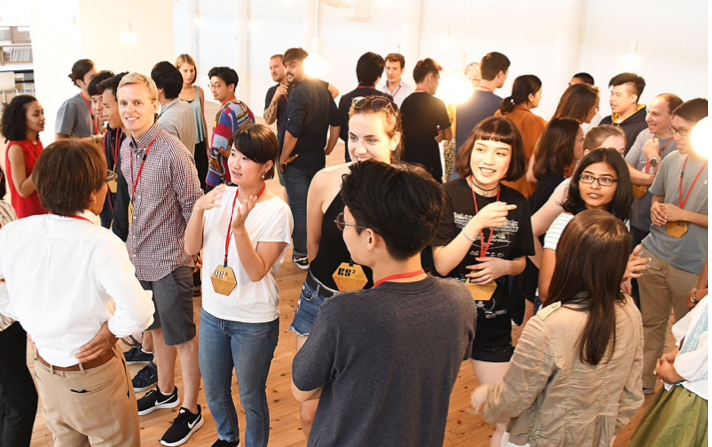
Icebreaker session during the Design Thinking module
The 2016 "beta-test" was mostly attended by local students, approximately half of them international students studying in Japan. The program was promoted to participants from overseas for the first time in 2017. While we were concerned that not enough international students would apply, we drew 199 applicants. In 2019, we had 170 applicants with the median age of 23 at the time of program start date.
For the first two years, the program was open to anyone. Since 2018, the following eligibility criteria was instituted:
● Current university students (Graduate and Undergraduate)
● Recent university graduates (Graduated in 2018 or later)
● Working for a startup (company younger than 3 years and less than 25 people)
● Freelancers with the intent of creating a startup
Most of the applicants were students or recent graduates and had not worked in a startup or founded a company yet. Some were active in the startup community working for accelerators or volunteering for events.
Geographically, most applicants were from Europe and Southeast Asia; 28 applicants were from Japan, but only 14 of them were Japanese. Despite our outreach it has been difficult to attract Japanese students, and the lack of English-language ability and the short summer holidays seem to be the biggest issues. Eight of those 28 applications were students at KIT who do not have to pay the participation fee and also receive course credit. The others included working professionals in their 40s or academics interested in benchmarking the program for their own activities.
There are three rounds of applications (the last one is conducted only if necessary) and the applicants are selected down to roughly 50, with the target of 35 participants.
Recruitment
Our partner institutions have helped us the most in reaching to international participants. KIT has approximately 100 partnerships with institutions in 30 different countries. The international office at KIT helped us send out emails to these institutions with template text that could be forwarded to students or posted on message boards. Most of these institutions are in Europe and Southeast Asia, which explains why so many applicants are from there.
Alumni of the program have helped us spread the word. Also, the KYOTO Design Lab is part of two design and innovation based academic networks, called the Design Factory Global Network and the SUGAR Network. Universities in both networks have been supportive in getting the word out to their students, generating more applicants. KS³ has not been as successful in attracting domestic participants.
Corporate participants
Since 2018, KS³ has offered a "corporate track" for working professionals who could benefit from the program. The corporate track consists of the first week of the program, which includes the Design Thinking and Lean Startup workshops. The corporate track participants join these workshops along with the regular participants. These two methodologies help both entrepreneurs and professionals in new product and business development.
Despite the shorter duration, the corporate track participation fee is set significantly higher than the regular track, as companies are expected to pay and not the individual. Besides introducing new innovation approaches to companies, the corporate track offsets the cost for regular participants.
For both 2018 and 2019, 10 spots were assigned for the corporate track but only four participants joined each year. Furthermore, despite the corporate track being intended for company employees, several academics joined the program as a way to benchmark the program. Recruitment of the corporate track participants remains a challenge.
Who teaches at KS³?
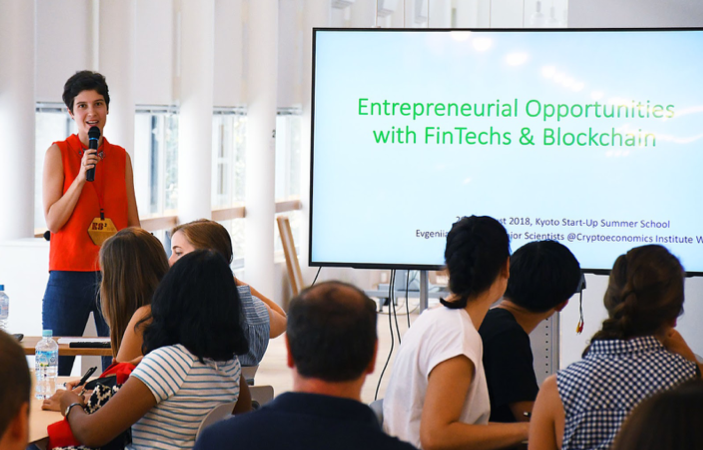
Lecture from 2018 about FinTech and Blockchain
The workshop facilitators and lecturers are what makes KS³ possible, and they come from all walks of life. The 2019 program included 22 people who were involved in teaching, excluding the people who joined the meetup, guided the company tours, and volunteered for the Startup Weekend. [See Appendix 2 for a breakdown of who taught at our 2019 session.]
While most of the workshop facilitators and lectures are compensated, the standard university rate is significantly limited. It is safe to say that all the people are motivated by contributing to the startup ecosystem rather than the financial reward. The people who conducted workshops and lectures pro bono came from organizations and companies that supported entrepreneurs where there was a clear value proposition in reaching out to aspiring entrepreneurs. We made sure that sessions weren't treated as recruiting sessions for these companies and organizations.
Impact
The exit survey included questions such as the participant's confidence in founding a company, self-assessment of their knowledge required for creating a startup, and the general satisfaction in the program. However, we did not have the expertise to conduct a scientific pre-post study with proper experimental design.
In the summer of 2020, a follow-up survey was conducted with the alumni to anecdotally investigate the impact that program has had in their careers. Of the 120 or so participants from 2017, 2018, and 2019, 34 responded. On a seven-point scale, the question, “How much impact did KS³ have on your career/life?,” received an average score of 5.6, while the question, “Looking back, how glad are you that you joined KS³?,” received an average score of 6.7.
Of the 34 respondents:
· 23 were not students or have graduated
· 11 were still students
· 6 joined other startup workshops and events like KS³
· 4 started volunteering at a startup-related organization
· 5 started organizing startup-related events
Of the 23 respondents who were no longer students:
· 4 founded companies
· 9 joined a startup
· 1 started working in the startup industry (e.g. accelerator, VC firm)
· 8 got a job in a regular company
· 1 joined an accelerator
· 8 started working on a startup idea on the side
Note that respondents were able to select multiple options in this survey.
While it’s difficult to ascertain the significance of these results without any comparative data sets, it’s interesting to note that the most common pathway for participants was to join a startup company. In the freeform answers, several participants commented that KS³ has made them realize that startups are a lot closer than they had expected. While KS³ has been operating with the mission statement of "getting aspiring entrepreneurs to a better starting line," one of its effects seems to be encouraging more young people to consider working for a startup.
Takeaways
If you build it, they will come
One of the biggest concerns when launching KS³ was that most people would be unable to travel to it. This turned out to be a non-issue because each year demand for the program has exceeded the spots available. From interacting with participants, we’ve concluded that the people who are interested in KS³ are students who are interested in entrepreneurship but have not taken the first steps to realizing their startup. Because of the increased buzz around startups worldwide, a subset of students would like to learn more before choosing to start or join one. Some of these students were willing to travel internationally for two weeks to satisfy their yearning for learning.
Modular format
While the KS³’s modular format hasn’t been proven as a teaching technique, participants often mentioned the diversity of content as their favorite aspect of the program. The modular format also allows for simple changes every year to accommodate the buzzing topic of the day. The challenges include finding the right workshop facilitators and lecturers, publicizing the program and coordinating it. Luckily, members of the greater entrepreneurship ecosystem operate in a pay-it-forward mentality, and finding people willing to teach have not been difficult. However, in the early years of the program, networking was crucial in helping us find these people.
Changing things up
One of the biggest criticisms in the early years of the program was that the modules’ format was too similar. We noticed that participants were having a hard time focusing after three or four straight lectures in one day. This encouraged us to add other kinds of modules to the workshops and lectures: meetups, company visits, panel discussions, and yoga and meditation sessions. The organizing team is considering other modules for the future while trying to balance the education and fun factor.
Focus on community
When initially building KS³, the founder of the program talked to several students who have been part of other similar summer programs at other universities. One student commented that at another program in Japan, the emphasis was purely on the workshop and the content and it was difficult to connect with the other participants. This was especially true for participants from East Asia, where people tend to be more shy at first.
As most KS³ participants haven't met one another other, we focus on building a feeling of community each year. A Facebook group set up before the event encourages all the participants to introduce themselves. The profiles of all the participants, workshop facilitators, lecturers, and organizers are included in the program book, which is sent before the program begins. An informal gathering at a local pub is organized for the day before the official first day for people to meet each other.
The above measures help kickstart the workshops on Day 1, where participants quickly jump into intense teamwork. Participants usually created a WhatsApp group amongst themselves and got out at night for food and drinks. The effect of the community can be seen years later, as past participants have sent updates on the Facebook group, which has turned into a de facto alumni group. For many of the participants who come from regions where the startup ecosystem is not vibrant, the community serves as a reminder that like-minded people around the world shared a similar experience for two intense weeks in Kyoto.
The future of KS³
As the novel coronavirus pandemic caused the 2020 program to be cancelled, the near-term goal is to get the program going again in 2021. This should not be difficult as most of the workshop facilitators and lecturers were already lined up, and close to 40 people applied for the 2020 program.
When KS³ initially started, the organizing team was not aware of the academic literature around entrepreneurship education and evaluating programs. Delving into the existing literature has shown us what we are doing right and where we can improve. While these improvements will be implemented, it’s difficult to imagine making a drastic change to the program any time soon, since participant feedback shows that the existing format is delivering good results. We are planning a more in-depth analysis of the program’s efficacy, with more rigorous academic design.
Beyond the program itself, we’ve discussed extending the program with an acceleration program. However, since of the KS³ participants are not from Japan and the goal of the program is not to create startups, such a program is not a logical fit. Moreover, many accelerators for students can be found around the world, including several in Kyoto.
One of our other goals it to make it possible for more Japanese students to participate in our program and to consider entrepreneurship. As the language barrier may be a big hurdle, the next step may be to create programs with local partners to raise the awareness of entrepreneurship as a career path for local students.
References
Blank, S., & Mullaney, K. (n.d.). How to Build a Startup. Retrieved March 3, 2016, from https://www.udacity.com/course/how-to-build-a-startup--ep245
Startup Weekend. (n.d.). Retrieved June 17, 2020, from https://startupweekend.org/
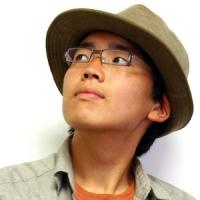
Associate Professor / Design & Architecture / Kyoto Institute of Technology
View Profile
